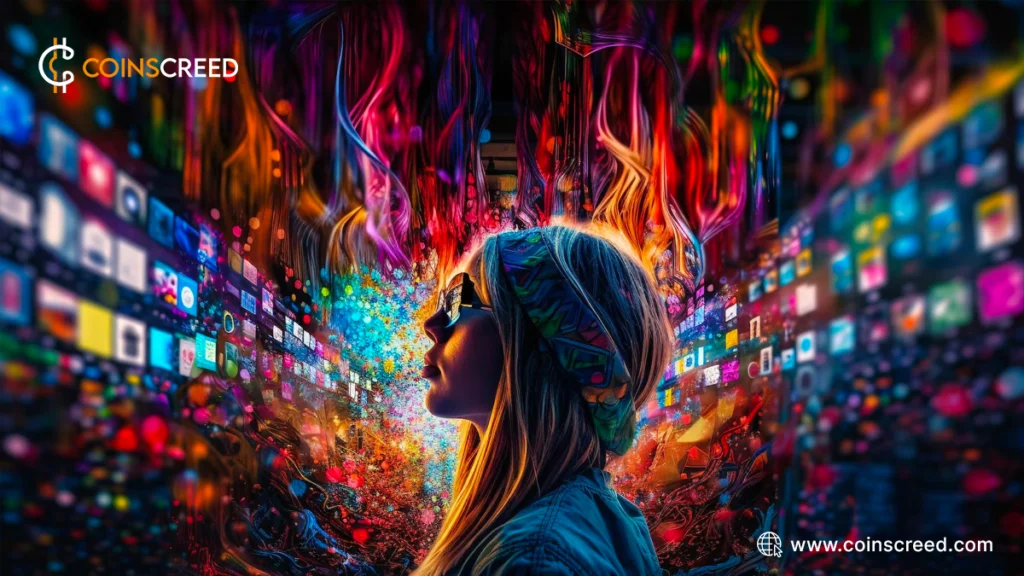The art world is profoundly transforming, driven by two technological revolutions, Non-Fungible Tokens (NFTs) and Artificial Intelligence (AI).

NFTs have gained immense popularity for their ability to authenticate and sell digital art, while AI is being harnessed to enhance the verification and protection of these digital assets.
In this article, we will explore the intersection of NFTs and AI, discussing how these innovations reshape the art market and unlock the future of digital art authentication.
What are NFTs?
NFTs, or Non-Fungible Tokens, are digital assets representing ownership or proof of authenticity of unique items, often digital art, music, collectibles, and virtual real estate. Unlike cryptocurrencies such as Bitcoin or Ethereum, NFTs cannot be exchanged one-to-one, as each token is distinct and inseparable. This uniqueness is what makes NFTs a game-changer in the art world.
NFTs Authentication and Ownership
Before the advent of NFTs, digital art was plagued by issues of authenticity and ownership. Artists struggled to prove the provenance of their work in the digital realm, leading to copyright infringement, unauthorized reproductions, and a lack of revenue from their creations.
NFTs address these concerns by utilizing blockchain technology to securely record and verify ownership and provenance.
Blockchain technology, which underlies NFTs, creates a transparent and immutable ledger of ownership. Each NFT is a unique token associated with a specific digital artwork, and this token is recorded on a blockchain, often Ethereum.
This ledger ensures that ownership and the history of transactions are tamper-proof, providing a transparent and verifiable chain of custody for digital art.
The Role of AI in NFTs
While NFTs have revolutionized digital art authentication and ownership, AI is playing an increasingly vital role in enhancing the security and value of these digital assets. Some of the roles in which AI plays include:
- Content Analysis
- Fraud Detection
- Content Protection
- Provenance Tracking
- Valuation and Pricing
- Marketplace Curation
Content Analysis
AI algorithms can analyze the content of digital art to detect plagiarism or unauthorized reproductions. They can compare an artwork’s composition, colors, and other visual elements to a vast database of existing art, helping to identify potential infringements.
Fraud Detection
AI can be used to detect fraudulent activity in the NFT marketplace. AI systems can flag suspect transactions, fake accounts, or artificially inflated prices, helping protect buyers and artists.
Content Protection
AI-driven watermarking and encryption techniques can be employed to protect digital art from unauthorized use. These methods make it more challenging for individuals to copy or reproduce the artwork without the artist’s permission.
Provenance Tracking
AI can assist in tracking the provenance of digital art by analyzing metadata and timestamps associated with NFT transactions. This ensures that the ownership history is accurate and transparent.
Valuation and Pricing
AI models can help determine the fair market value of NFTs by considering factors such as an artist’s reputation, historical sales data, and the uniqueness of the digital art. This can prevent overpricing or underpricing in the marketplace.
Marketplace Curation
AI-powered algorithms can aid in curating NFT marketplaces, making it easier for collectors to discover new artists and artworks that match their preferences. This can facilitate fairer exposure for emerging artists.
Benefits of AI in the world of NFTs
The combination of NFTs and AI creates a synergistic relationship that addresses many of the challenges faced by the digital art world. NFTs provide the foundation for secure ownership and provenance tracking, while AI enhances the authentication and protection of these assets. Together, they unlock the future of digital art authentication in several ways, which include:
- Enhanced Trust
- Reduced Fraud Rate
- Increased Revenue for Artists
- Improved User Experience
- Art Market Innovation
Enhanced Trust
Integrating AI-powered authentication systems within NFT marketplaces enhances trust and transparency for buyers and collectors. They can be confident in the authenticity of the digital art they purchase.
Reduced Fraud Rate
AI algorithms can proactively identify and prevent fraudulent activities, making the NFT marketplace safer for all participants.
Increased Revenue for Artists
AI can help artists protect their work from unauthorized use, ensuring they receive proper compensation for their creations. This encourages more artists to embrace digital mediums.
Improved User Experience
AI-driven curation and recommendation systems improve the overall user experience in NFT marketplaces, helping collectors discover new artists and artworks tailored to their tastes.
Art Market Innovation
The combination of NFTs and AI pushes the boundaries of what is possible in the art market. New forms of digital art, including generative art and AI-assisted creations, are gaining recognition and value.
Challenges and Considerations Associated with the use of AI in NFTs
While the integration of NFTs and AI offers numerous benefits, there are also challenges and ethical considerations to address, some of which are:
- AI Bias
- Privacy
- Legal Frameworks
AI Bias
AI algorithms used for content analysis and valuation can inherit biases from the data they are trained on. Efforts must be made to ensure fairness and diversity in these models.
Privacy
AI-driven content protection measures may raise concerns about privacy if they collect and analyze user data. Striking a balance between protection and privacy is crucial.
Legal Frameworks
The legal status of NFTs and AI-driven art authentication is evolving. Clear regulations are needed to protect the rights of artists and collectors and ensure a stable marketplace.
Conclusion
NFTs and AI are reshaping the art world by revolutionizing digital art authentication and ownership. NFTs provide a secure foundation for proving ownership and provenance, while AI enhances digital art assets’ security, authenticity, and value.
This synergy unlocks new opportunities for artists, collectors, and the broader art market. However, it also brings challenges that must be carefully addressed to ensure these transformative technologies’ sustainable growth and ethical use of NFTs and AI continue to evolve.
The future of digital art authentication promises to be exciting and complex, pushing the boundaries of what is possible in the digital art landscape.
